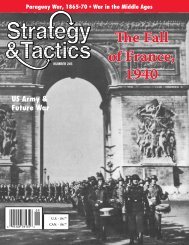COUNTERSTROKE AT SOLTSY - Strategy & Tactics Press
COUNTERSTROKE AT SOLTSY - Strategy & Tactics Press
COUNTERSTROKE AT SOLTSY - Strategy & Tactics Press
You also want an ePaper? Increase the reach of your titles
YUMPU automatically turns print PDFs into web optimized ePapers that Google loves.
Preoccupied with his civil war,<br />
Antiochus sent one of his relatives,<br />
a general named Lysias, against the<br />
Judeans. Lysias’s level of military experience<br />
and acumen remain unclear,<br />
but it didn’t take an Alexander to<br />
comprehend his instructions: “Uproot<br />
and destroy the strength of Israel and<br />
the remnant of Judea. Blot out all<br />
memory of them in the place. Settle<br />
strangers in the territory and allot the<br />
land to the settlers.” (I Maccabees,<br />
chapter three, verses 36-37.)<br />
Already numbering approximately<br />
20,000 men, the Seleucids were<br />
further reinforced by an unrecorded<br />
number of Idumean troops at their<br />
sprawling encampment just to the<br />
south of Judea. That bivouac also<br />
hosted large numbers of slave traders,<br />
all anticipating a bonanza upon the<br />
defeat of the insurgents. Those merchants<br />
brought not only chains, but<br />
also hefty amounts of gold and silver<br />
in anticipation of setting up a lucrative<br />
market. The camp itself therefore<br />
become a rich prize.<br />
Learning from his spies the<br />
Seleucids planned to attack at night,<br />
Judah abandoned his own camp after<br />
lighting a number of bonfires to make<br />
it appear still fully occupied. While<br />
6,000 Seleucids groped in darkness,<br />
searching for the elusive rebels, the<br />
Jews circled behind them to assault<br />
their camp at dawn. And attack the<br />
Judeans did. Amid the pandemonium<br />
of stampeding horses and elephants,<br />
the invaders were cut to pieces while<br />
panicked survivors fled in disorder<br />
toward the coast.<br />
The victors helped themselves to<br />
the treasures of the captured enemy<br />
camp, which included yet another<br />
massive cache of weapons. News of<br />
the plunder swelled Judah’s army to<br />
around 10,000, all spoiling for further<br />
action.<br />
Lysias escaped the debacle, made<br />
it back to Syria, and frantically raised<br />
yet another expeditionary force, hoping<br />
to surprise the Judeans by returning<br />
more quickly than they expected,<br />
as well as salvaging his own reputation<br />
with his master Antiochus. The<br />
Maccabees, however, remained ready,<br />
and easily routed the new force near<br />
the city of Beth-zur in southernmost<br />
Judea.<br />
After Judah upended yet another<br />
large Syrian invasion in the spring of<br />
161, the Seleucids broke off action for<br />
a year, lulling the Judeans into believ-<br />
ing they had won. The Maccabean<br />
army began to disperse, and in 160BC<br />
the Judeans were unable to survive a<br />
new, massive and unexpected attack.<br />
Judah himself was killed in the final<br />
battle.<br />
The Maccabean Revolt died along<br />
with the leader who had made it<br />
possible, but it was not a real victory<br />
for the Seleucids. Their empire had<br />
bled too much during the eight year<br />
uprising. Its armies were depleted and<br />
its coffers drained. Before long, the<br />
ascendant Roman Republic moved<br />
in and conducted what was one of<br />
their easiest conquests enroute to their<br />
mastery of the Mediterranean littoral.<br />
— Kelly Bell<br />
Codename Blue<br />
Peacock<br />
During the early days of the<br />
Cold War, western Europe was hard<br />
pressed. The British, then responsible<br />
for halting any potential Warsaw Pact<br />
sweep across the Northern German<br />
Plain, lacked the financial and manpower<br />
resources of the United States.<br />
So the British government came to<br />
believe stopping the “Red hordes”<br />
might call for desperate measures.<br />
One solution explored was an<br />
atomic land mine, for which a War<br />
Office “specification” was issued in<br />
1954. The document called for a 10<br />
kiloton device that could be triggered<br />
remotely from up to three miles away,<br />
or by a clockwork timer that could<br />
be set for up to an eight-day delay. A<br />
study followed in 1955. Its conclusion<br />
was that atomic mines buried<br />
in northern Germany could indeed<br />
thwart a Soviet advance across the flat<br />
expanses of the British sector.<br />
In 1955, Britain’s nuclear arsenal<br />
was limited to one design, the “Blue<br />
Danube” bomb, first tested in 1952<br />
and then in service with the Royal Air<br />
Force. The Blue Danube, a plutonium<br />
bomb, had been created as a free-fall<br />
aerial device, carried to its target in a<br />
bomber. In 1955 it was the only nuclear<br />
weapon immediately available<br />
to the British. The design became the<br />
basis for the army’s new atomic land<br />
mine, codenamed “Blue Peacock.”<br />
Converting the Blue Danube to<br />
an army munition offered challenges.<br />
The weapon was big: Blue Danube<br />
weighed 10,000 pounds, was over 24<br />
feet long and five feet, two inches in<br />
diameter. It was intended to be stored<br />
under climate-controlled conditions,<br />
and it was expected to be under the<br />
control of the British military until<br />
it had been delivered. Blue Peacock<br />
would – by its very nature as a supermine<br />
– be left alone for up to a week<br />
in primitive field conditions.<br />
Blue Peacock ended up using the<br />
Blue Danube detonation system in<br />
a larger casing that was also made<br />
waterproof and airtight. It could<br />
therefore be buried, dumped into a<br />
lake or river, or simply left on the<br />
ground. A surface burst would create<br />
a 375 foot crater. Buried 35 feet deep,<br />
Blue Peacock would dig a hole 640<br />
feet across.<br />
Since the bomb would be untended,<br />
anti-tamper devices were<br />
also added. The casing was pressurized,<br />
and pressure switches and tilt<br />
switches were added. Once armed,<br />
Blue Peacock would detonate 10 seconds<br />
after being moved, if the casing<br />
lost pressure (for example, if gunfire<br />
punctured it), or if it was filled with<br />
water.<br />
Field tests indicated a European<br />
winter might chill the bomb below<br />
the detonator’s operating temperature.<br />
Therefore the bomb was insulated<br />
with fiberglass batting, and a unique<br />
heating system added – live chickens.<br />
The birds were to be sealed inside<br />
the casing with a week’s worth of<br />
birdseed and water. The fowls’ body<br />
heat would keep the detonator warm<br />
enough to fire, at which time Blue<br />
Peacock would flash-fry the birds<br />
along with everything else within<br />
its range. [Talk about a “chicken<br />
outfit”…ed.]<br />
The Army Council ordered 10<br />
Blue Peacock mines in July 1957, and<br />
Britain’s atomic weapons establishment<br />
built two inert prototypes later<br />
that year. One of them was used to<br />
test the design in a gravel pit near<br />
Seven Oaks. Only then did wiser<br />
heads decide the project was too<br />
desperate.<br />
Blue Peacock had meanwhile<br />
grown to 16,000 pounds (weight, not<br />
cost in Sterling). Operational deployment<br />
of the weapon would therefore<br />
have required an item the size a<br />
large locomotive boiler to have been<br />
secretly trucked around Germany.<br />
Various devices were to be used to<br />
disguise the mine’s purpose. One<br />
cover story called for Blue Peacock to<br />
be described as “an atomic power unit<br />
for troops in the field” – an accurate,<br />
strategy & tactics 33







